NRSG139: Reflecting on Therapeutic Relationships in Nursing
VerifiedAdded on 2023/06/11
|50
|15994
|451
Essay
AI Summary
This essay examines the establishment of therapeutic nurse-client relationships within community mental health settings. It begins by highlighting the significance of mental well-being and the prevalence of mental health disorders globally and in Finland, further explaining the importance of therapeutic relationships in mental health care, defining it as a foundation for changing patient insight and behavior. Using a literature review methodology, the study analyzes fourteen scientific articles to identify core components of effective nurse-client relationships, including trust, communication, empathy, genuineness, empowerment, respect, continuity of care, and patient confidentiality. The role of nurses in providing physical care, safety, security, and protection is also explored. Hildegard Peplau's interpersonal theory serves as the theoretical framework, explaining the phases of therapeutic nurse-client relationship. The essay concludes by emphasizing the vital role of nurses in providing comprehensive care and fostering therapeutic alliances to improve patient outcomes. Desklib offers a wealth of similar resources, including past papers and solved assignments, to aid students in their studies.
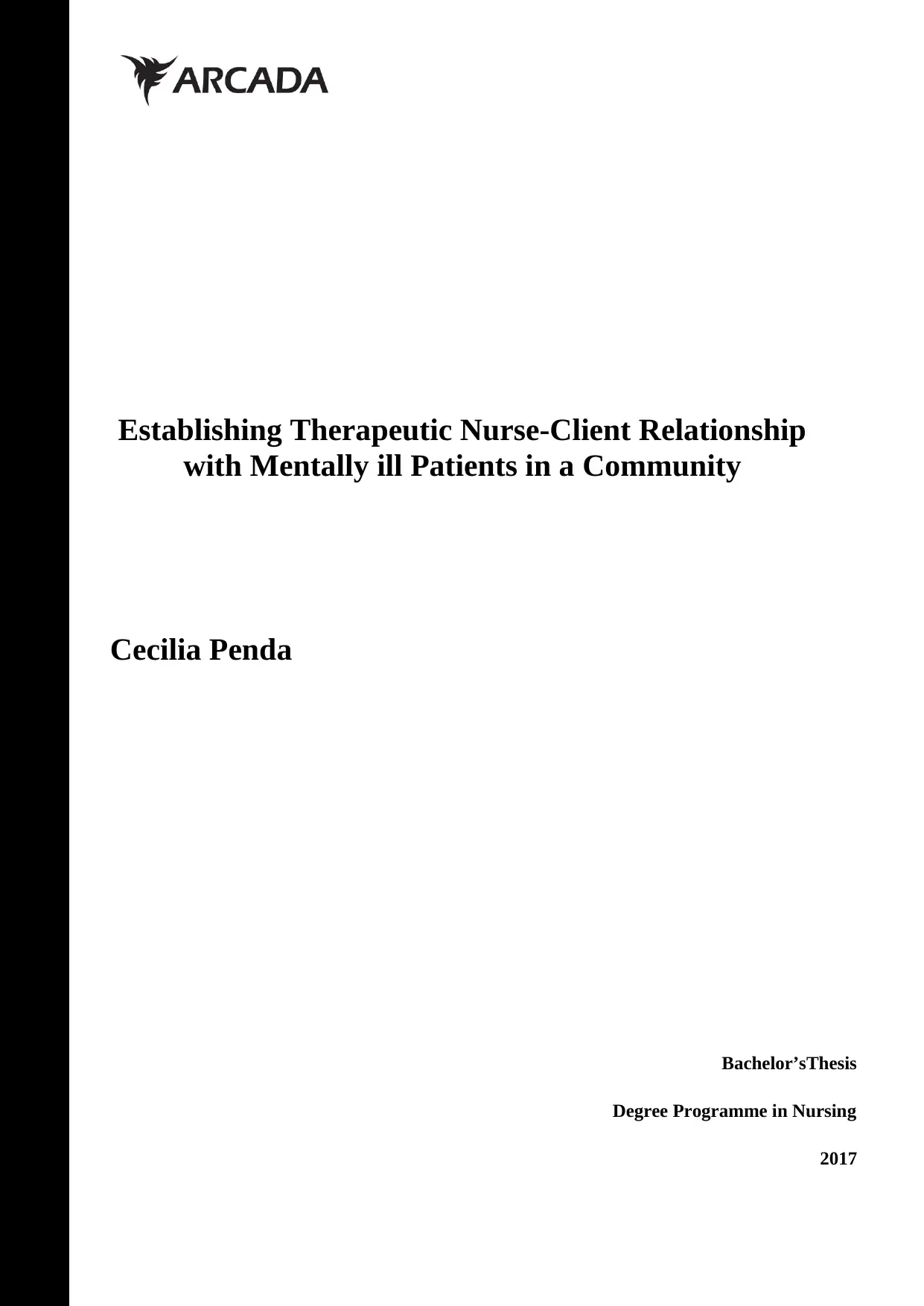
Establishing Therapeutic Nurse-Client Relationship
with Mentally ill Patients in a Community
Cecilia Penda
Bachelor’sThesis
Degree Programme in Nursing
2017
with Mentally ill Patients in a Community
Cecilia Penda
Bachelor’sThesis
Degree Programme in Nursing
2017
Paraphrase This Document
Need a fresh take? Get an instant paraphrase of this document with our AI Paraphraser
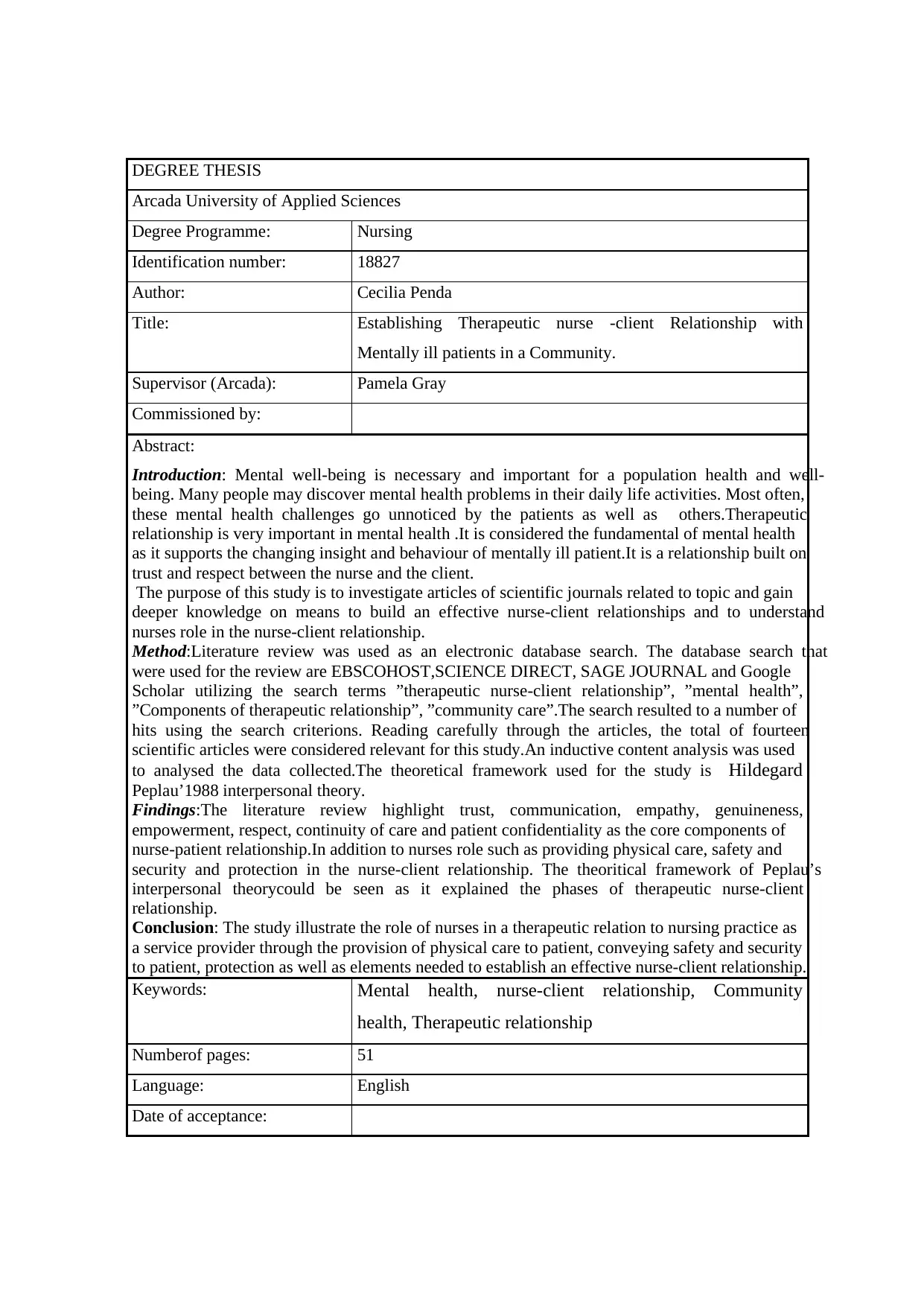
DEGREE THESIS
Arcada University of Applied Sciences
Degree Programme: Nursing
Identification number: 18827
Author: Cecilia Penda
Title: Establishing Therapeutic nurse -client Relationship with
Mentally ill patients in a Community.
Supervisor (Arcada): Pamela Gray
Commissioned by:
Abstract:
Introduction: Mental well-being is necessary and important for a population health and well-
being. Many people may discover mental health problems in their daily life activities. Most often,
these mental health challenges go unnoticed by the patients as well as others.Therapeutic
relationship is very important in mental health .It is considered the fundamental of mental health
as it supports the changing insight and behaviour of mentally ill patient.It is a relationship built on
trust and respect between the nurse and the client.
The purpose of this study is to investigate articles of scientific journals related to topic and gain
deeper knowledge on means to build an effective nurse-client relationships and to understand
nurses role in the nurse-client relationship.
Method:Literature review was used as an electronic database search. The database search that
were used for the review are EBSCOHOST,SCIENCE DIRECT, SAGE JOURNAL and Google
Scholar utilizing the search terms ”therapeutic nurse-client relationship”, ”mental health”,
”Components of therapeutic relationship”, ”community care”.The search resulted to a number of
hits using the search criterions. Reading carefully through the articles, the total of fourteen
scientific articles were considered relevant for this study.An inductive content analysis was used
to analysed the data collected.The theoretical framework used for the study is Hildegard
Peplau’1988 interpersonal theory.
Findings:The literature review highlight trust, communication, empathy, genuineness,
empowerment, respect, continuity of care and patient confidentiality as the core components of
nurse-patient relationship.In addition to nurses role such as providing physical care, safety and
security and protection in the nurse-client relationship. The theoritical framework of Peplau’s
interpersonal theorycould be seen as it explained the phases of therapeutic nurse-client
relationship.
Conclusion: The study illustrate the role of nurses in a therapeutic relation to nursing practice as
a service provider through the provision of physical care to patient, conveying safety and security
to patient, protection as well as elements needed to establish an effective nurse-client relationship.
Keywords: Mental health, nurse-client relationship, Community
health, Therapeutic relationship
Numberof pages: 51
Language: English
Date of acceptance:
Arcada University of Applied Sciences
Degree Programme: Nursing
Identification number: 18827
Author: Cecilia Penda
Title: Establishing Therapeutic nurse -client Relationship with
Mentally ill patients in a Community.
Supervisor (Arcada): Pamela Gray
Commissioned by:
Abstract:
Introduction: Mental well-being is necessary and important for a population health and well-
being. Many people may discover mental health problems in their daily life activities. Most often,
these mental health challenges go unnoticed by the patients as well as others.Therapeutic
relationship is very important in mental health .It is considered the fundamental of mental health
as it supports the changing insight and behaviour of mentally ill patient.It is a relationship built on
trust and respect between the nurse and the client.
The purpose of this study is to investigate articles of scientific journals related to topic and gain
deeper knowledge on means to build an effective nurse-client relationships and to understand
nurses role in the nurse-client relationship.
Method:Literature review was used as an electronic database search. The database search that
were used for the review are EBSCOHOST,SCIENCE DIRECT, SAGE JOURNAL and Google
Scholar utilizing the search terms ”therapeutic nurse-client relationship”, ”mental health”,
”Components of therapeutic relationship”, ”community care”.The search resulted to a number of
hits using the search criterions. Reading carefully through the articles, the total of fourteen
scientific articles were considered relevant for this study.An inductive content analysis was used
to analysed the data collected.The theoretical framework used for the study is Hildegard
Peplau’1988 interpersonal theory.
Findings:The literature review highlight trust, communication, empathy, genuineness,
empowerment, respect, continuity of care and patient confidentiality as the core components of
nurse-patient relationship.In addition to nurses role such as providing physical care, safety and
security and protection in the nurse-client relationship. The theoritical framework of Peplau’s
interpersonal theorycould be seen as it explained the phases of therapeutic nurse-client
relationship.
Conclusion: The study illustrate the role of nurses in a therapeutic relation to nursing practice as
a service provider through the provision of physical care to patient, conveying safety and security
to patient, protection as well as elements needed to establish an effective nurse-client relationship.
Keywords: Mental health, nurse-client relationship, Community
health, Therapeutic relationship
Numberof pages: 51
Language: English
Date of acceptance:
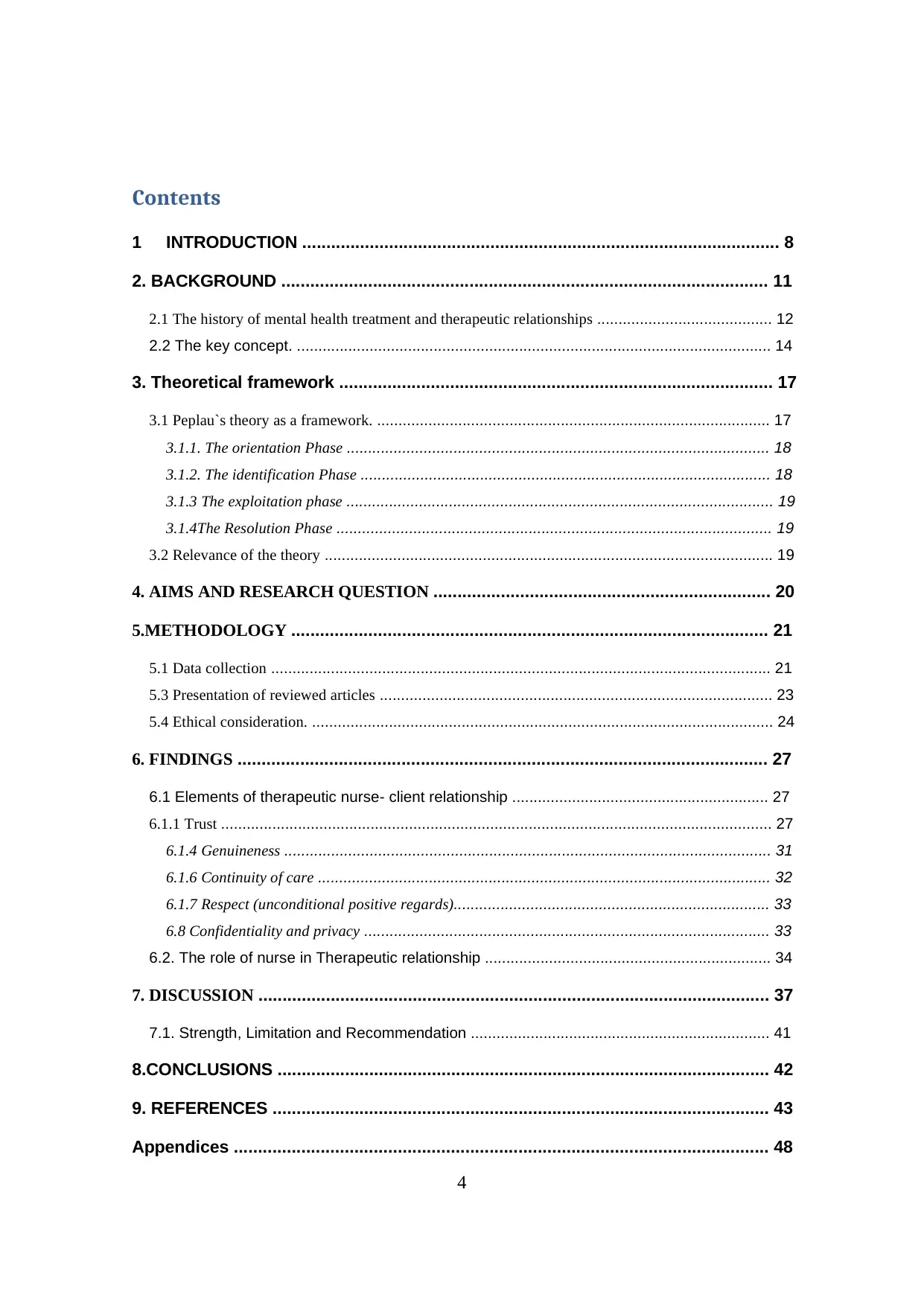
4
Contents
1 INTRODUCTION ................................................................................................... 8
2. BACKGROUND ..................................................................................................... 11
2.1 The history of mental health treatment and therapeutic relationships ......................................... 12
2.2 The key concept. ............................................................................................................... 14
3. Theoretical framework .......................................................................................... 17
3.1 Peplau`s theory as a framework. ............................................................................................ 17
3.1.1. The orientation Phase ................................................................................................... 18
3.1.2. The identification Phase ................................................................................................ 18
3.1.3 The exploitation phase .................................................................................................... 19
3.1.4The Resolution Phase ...................................................................................................... 19
3.2 Relevance of the theory ......................................................................................................... 19
4. AIMS AND RESEARCH QUESTION ...................................................................... 20
5.METHODOLOGY ................................................................................................... 21
5.1 Data collection ..................................................................................................................... 21
5.3 Presentation of reviewed articles ............................................................................................ 23
5.4 Ethical consideration. ............................................................................................................ 24
6. FINDINGS .............................................................................................................. 27
6.1 Elements of therapeutic nurse- client relationship ............................................................ 27
6.1.1 Trust ................................................................................................................................. 27
6.1.4 Genuineness .................................................................................................................. 31
6.1.6 Continuity of care .......................................................................................................... 32
6.1.7 Respect (unconditional positive regards).......................................................................... 33
6.8 Confidentiality and privacy ............................................................................................... 33
6.2. The role of nurse in Therapeutic relationship ................................................................... 34
7. DISCUSSION .......................................................................................................... 37
7.1. Strength, Limitation and Recommendation ...................................................................... 41
8.CONCLUSIONS ...................................................................................................... 42
9. REFERENCES ....................................................................................................... 43
Appendices ............................................................................................................... 48
Contents
1 INTRODUCTION ................................................................................................... 8
2. BACKGROUND ..................................................................................................... 11
2.1 The history of mental health treatment and therapeutic relationships ......................................... 12
2.2 The key concept. ............................................................................................................... 14
3. Theoretical framework .......................................................................................... 17
3.1 Peplau`s theory as a framework. ............................................................................................ 17
3.1.1. The orientation Phase ................................................................................................... 18
3.1.2. The identification Phase ................................................................................................ 18
3.1.3 The exploitation phase .................................................................................................... 19
3.1.4The Resolution Phase ...................................................................................................... 19
3.2 Relevance of the theory ......................................................................................................... 19
4. AIMS AND RESEARCH QUESTION ...................................................................... 20
5.METHODOLOGY ................................................................................................... 21
5.1 Data collection ..................................................................................................................... 21
5.3 Presentation of reviewed articles ............................................................................................ 23
5.4 Ethical consideration. ............................................................................................................ 24
6. FINDINGS .............................................................................................................. 27
6.1 Elements of therapeutic nurse- client relationship ............................................................ 27
6.1.1 Trust ................................................................................................................................. 27
6.1.4 Genuineness .................................................................................................................. 31
6.1.6 Continuity of care .......................................................................................................... 32
6.1.7 Respect (unconditional positive regards).......................................................................... 33
6.8 Confidentiality and privacy ............................................................................................... 33
6.2. The role of nurse in Therapeutic relationship ................................................................... 34
7. DISCUSSION .......................................................................................................... 37
7.1. Strength, Limitation and Recommendation ...................................................................... 41
8.CONCLUSIONS ...................................................................................................... 42
9. REFERENCES ....................................................................................................... 43
Appendices ............................................................................................................... 48
⊘ This is a preview!⊘
Do you want full access?
Subscribe today to unlock all pages.

Trusted by 1+ million students worldwide
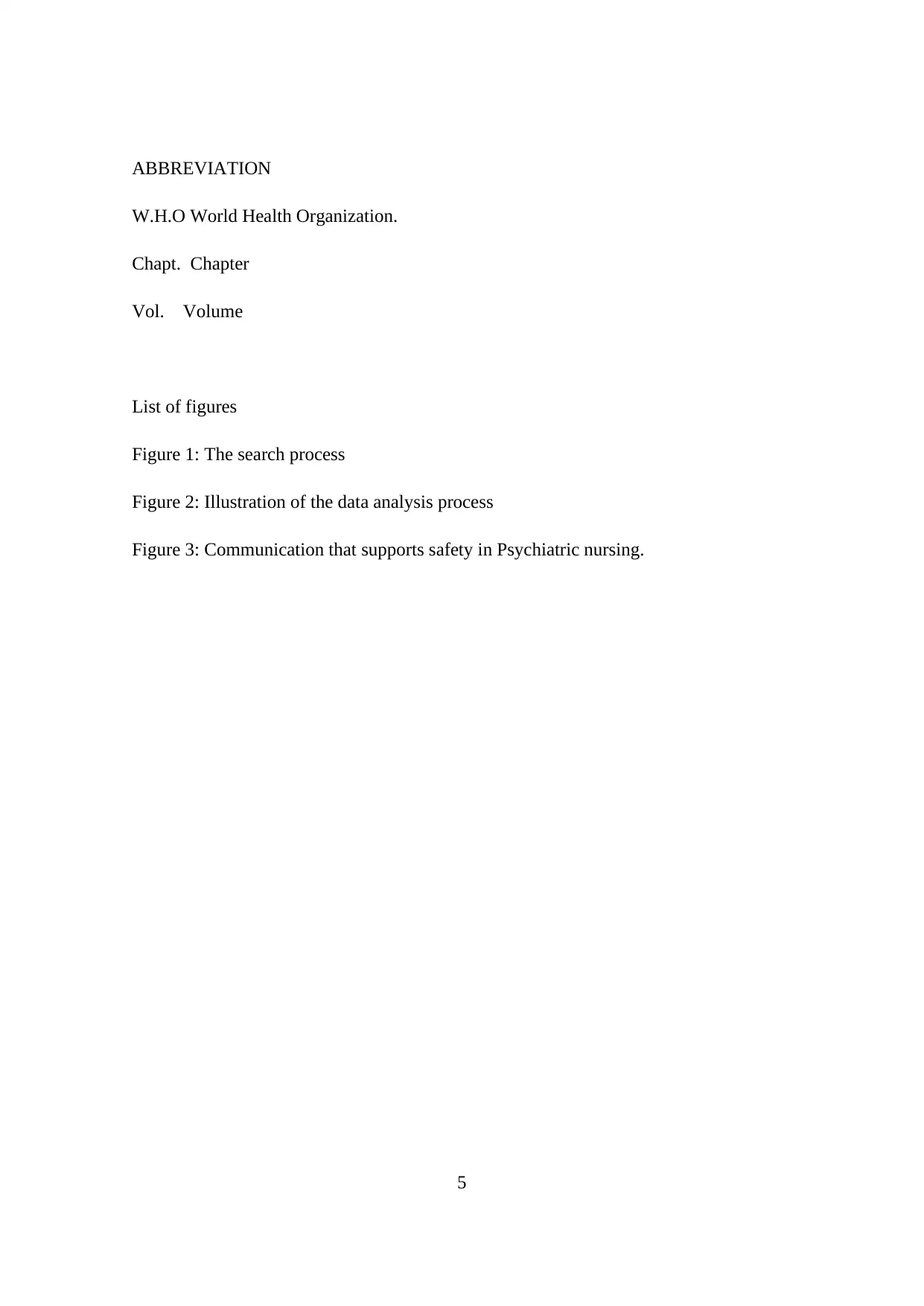
5
ABBREVIATION
W.H.O World Health Organization.
Chapt. Chapter
Vol. Volume
List of figures
Figure 1: The search process
Figure 2: Illustration of the data analysis process
Figure 3: Communication that supports safety in Psychiatric nursing.
ABBREVIATION
W.H.O World Health Organization.
Chapt. Chapter
Vol. Volume
List of figures
Figure 1: The search process
Figure 2: Illustration of the data analysis process
Figure 3: Communication that supports safety in Psychiatric nursing.
Paraphrase This Document
Need a fresh take? Get an instant paraphrase of this document with our AI Paraphraser

6
Dedication
Dedicated to my beloved sons Pekka – Kelton & Clive
Dedication
Dedicated to my beloved sons Pekka – Kelton & Clive

7
Acknowledgement
I am grateful to God almighty for the guidance and support provided to me throughout
the writing of this study.
I wish to express my sincere gratitude to my supervisor Pamela Gray for her encour-
agements, supports and reviews that brought this work to fulfillment. Not leaving out all
the academic staffs in the Arcada Nursing Department who in one way or the other con-
tributed to make my studies and the writing of this paper a success, thank you so much.
I would like to take this chance to express my deep sense of gratitude to my beloved
mothers, brothers and sisters for their support and understanding and to my late father
Mr. Ngoh Emmanuel Penda, who made me to be who I am today. I know you are happy
where you are now for this great achievement, thank you so much.
This study couldn’t have been accomplished without the support of this wonderful,
lovely family of Heli Norja and Matti Norja. Thank you for your enormous support
morally, financially and physically. Your encouragement when the times got tough, it
was a great comfort and reliefs to know that you were and are still willing provide any-
thing you can to see that I succeed. God bless you.
To my classmates and friends, Bola, Gordon& Celine, Susanna and to those whose
names are not mentioned here. They are worthy and trusted people who gave me their
support and ask for nothing in return. A big thank you.
I would like to thank my sons for his unique kindness and understanding he showed to
me throughout the writing of this study.
Acknowledgement
I am grateful to God almighty for the guidance and support provided to me throughout
the writing of this study.
I wish to express my sincere gratitude to my supervisor Pamela Gray for her encour-
agements, supports and reviews that brought this work to fulfillment. Not leaving out all
the academic staffs in the Arcada Nursing Department who in one way or the other con-
tributed to make my studies and the writing of this paper a success, thank you so much.
I would like to take this chance to express my deep sense of gratitude to my beloved
mothers, brothers and sisters for their support and understanding and to my late father
Mr. Ngoh Emmanuel Penda, who made me to be who I am today. I know you are happy
where you are now for this great achievement, thank you so much.
This study couldn’t have been accomplished without the support of this wonderful,
lovely family of Heli Norja and Matti Norja. Thank you for your enormous support
morally, financially and physically. Your encouragement when the times got tough, it
was a great comfort and reliefs to know that you were and are still willing provide any-
thing you can to see that I succeed. God bless you.
To my classmates and friends, Bola, Gordon& Celine, Susanna and to those whose
names are not mentioned here. They are worthy and trusted people who gave me their
support and ask for nothing in return. A big thank you.
I would like to thank my sons for his unique kindness and understanding he showed to
me throughout the writing of this study.
⊘ This is a preview!⊘
Do you want full access?
Subscribe today to unlock all pages.

Trusted by 1+ million students worldwide
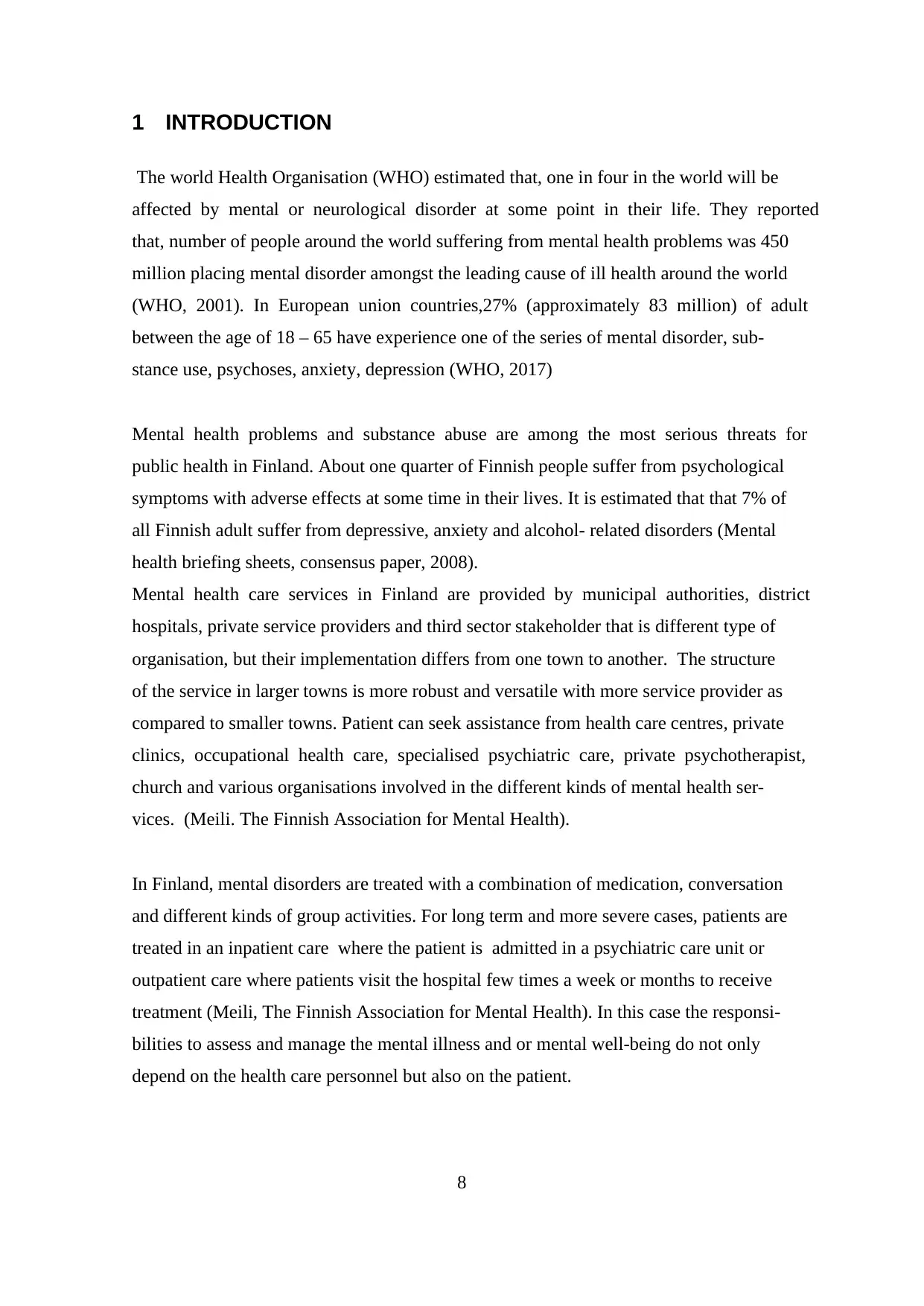
8
1 INTRODUCTION
The world Health Organisation (WHO) estimated that, one in four in the world will be
affected by mental or neurological disorder at some point in their life. They reported
that, number of people around the world suffering from mental health problems was 450
million placing mental disorder amongst the leading cause of ill health around the world
(WHO, 2001). In European union countries,27% (approximately 83 million) of adult
between the age of 18 – 65 have experience one of the series of mental disorder, sub-
stance use, psychoses, anxiety, depression (WHO, 2017)
Mental health problems and substance abuse are among the most serious threats for
public health in Finland. About one quarter of Finnish people suffer from psychological
symptoms with adverse effects at some time in their lives. It is estimated that that 7% of
all Finnish adult suffer from depressive, anxiety and alcohol- related disorders (Mental
health briefing sheets, consensus paper, 2008).
Mental health care services in Finland are provided by municipal authorities, district
hospitals, private service providers and third sector stakeholder that is different type of
organisation, but their implementation differs from one town to another. The structure
of the service in larger towns is more robust and versatile with more service provider as
compared to smaller towns. Patient can seek assistance from health care centres, private
clinics, occupational health care, specialised psychiatric care, private psychotherapist,
church and various organisations involved in the different kinds of mental health ser-
vices. (Meili. The Finnish Association for Mental Health).
In Finland, mental disorders are treated with a combination of medication, conversation
and different kinds of group activities. For long term and more severe cases, patients are
treated in an inpatient care where the patient is admitted in a psychiatric care unit or
outpatient care where patients visit the hospital few times a week or months to receive
treatment (Meili, The Finnish Association for Mental Health). In this case the responsi-
bilities to assess and manage the mental illness and or mental well-being do not only
depend on the health care personnel but also on the patient.
1 INTRODUCTION
The world Health Organisation (WHO) estimated that, one in four in the world will be
affected by mental or neurological disorder at some point in their life. They reported
that, number of people around the world suffering from mental health problems was 450
million placing mental disorder amongst the leading cause of ill health around the world
(WHO, 2001). In European union countries,27% (approximately 83 million) of adult
between the age of 18 – 65 have experience one of the series of mental disorder, sub-
stance use, psychoses, anxiety, depression (WHO, 2017)
Mental health problems and substance abuse are among the most serious threats for
public health in Finland. About one quarter of Finnish people suffer from psychological
symptoms with adverse effects at some time in their lives. It is estimated that that 7% of
all Finnish adult suffer from depressive, anxiety and alcohol- related disorders (Mental
health briefing sheets, consensus paper, 2008).
Mental health care services in Finland are provided by municipal authorities, district
hospitals, private service providers and third sector stakeholder that is different type of
organisation, but their implementation differs from one town to another. The structure
of the service in larger towns is more robust and versatile with more service provider as
compared to smaller towns. Patient can seek assistance from health care centres, private
clinics, occupational health care, specialised psychiatric care, private psychotherapist,
church and various organisations involved in the different kinds of mental health ser-
vices. (Meili. The Finnish Association for Mental Health).
In Finland, mental disorders are treated with a combination of medication, conversation
and different kinds of group activities. For long term and more severe cases, patients are
treated in an inpatient care where the patient is admitted in a psychiatric care unit or
outpatient care where patients visit the hospital few times a week or months to receive
treatment (Meili, The Finnish Association for Mental Health). In this case the responsi-
bilities to assess and manage the mental illness and or mental well-being do not only
depend on the health care personnel but also on the patient.
Paraphrase This Document
Need a fresh take? Get an instant paraphrase of this document with our AI Paraphraser
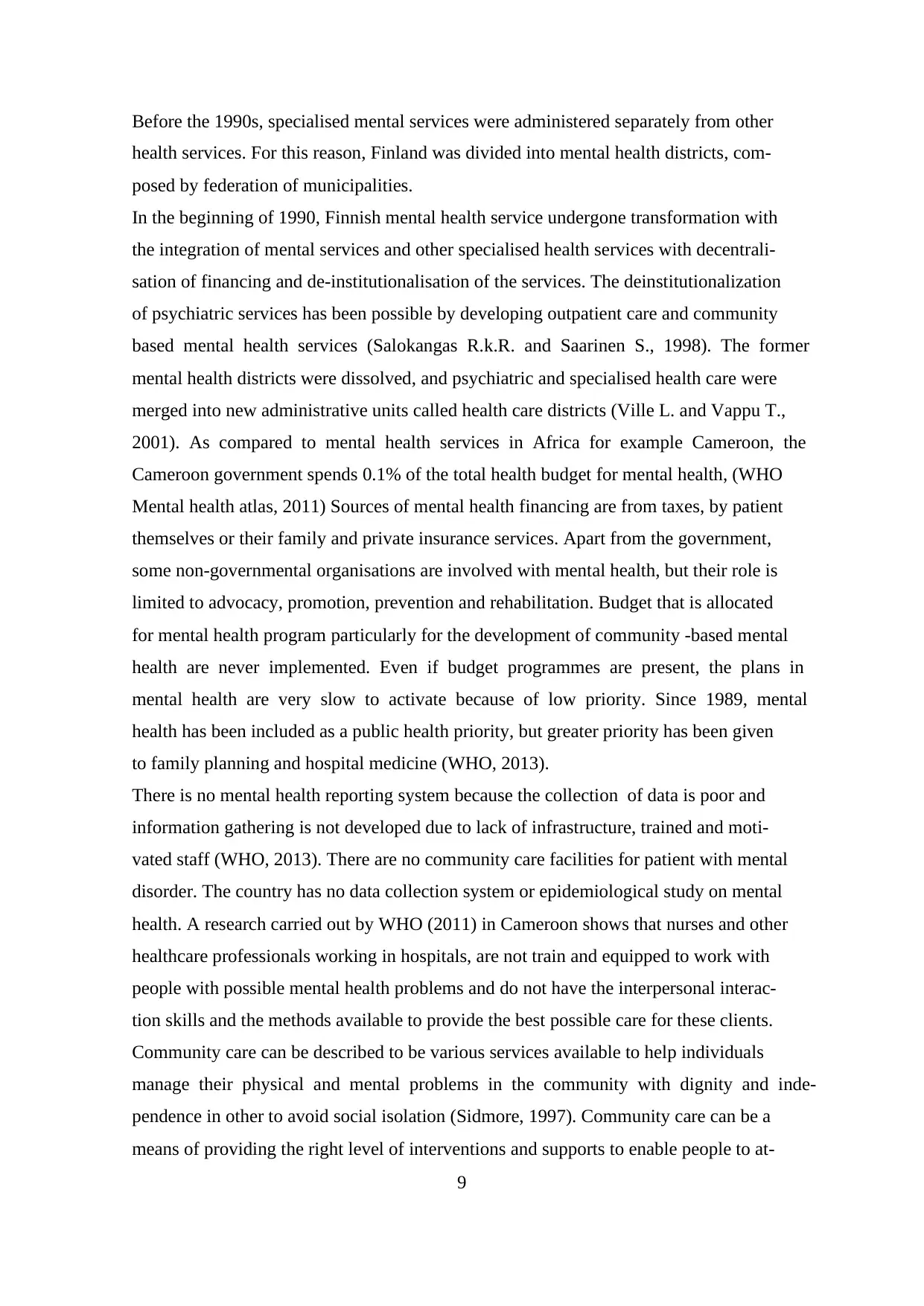
9
Before the 1990s, specialised mental services were administered separately from other
health services. For this reason, Finland was divided into mental health districts, com-
posed by federation of municipalities.
In the beginning of 1990, Finnish mental health service undergone transformation with
the integration of mental services and other specialised health services with decentrali-
sation of financing and de-institutionalisation of the services. The deinstitutionalization
of psychiatric services has been possible by developing outpatient care and community
based mental health services (Salokangas R.k.R. and Saarinen S., 1998). The former
mental health districts were dissolved, and psychiatric and specialised health care were
merged into new administrative units called health care districts (Ville L. and Vappu T.,
2001). As compared to mental health services in Africa for example Cameroon, the
Cameroon government spends 0.1% of the total health budget for mental health, (WHO
Mental health atlas, 2011) Sources of mental health financing are from taxes, by patient
themselves or their family and private insurance services. Apart from the government,
some non-governmental organisations are involved with mental health, but their role is
limited to advocacy, promotion, prevention and rehabilitation. Budget that is allocated
for mental health program particularly for the development of community -based mental
health are never implemented. Even if budget programmes are present, the plans in
mental health are very slow to activate because of low priority. Since 1989, mental
health has been included as a public health priority, but greater priority has been given
to family planning and hospital medicine (WHO, 2013).
There is no mental health reporting system because the collection of data is poor and
information gathering is not developed due to lack of infrastructure, trained and moti-
vated staff (WHO, 2013). There are no community care facilities for patient with mental
disorder. The country has no data collection system or epidemiological study on mental
health. A research carried out by WHO (2011) in Cameroon shows that nurses and other
healthcare professionals working in hospitals, are not train and equipped to work with
people with possible mental health problems and do not have the interpersonal interac-
tion skills and the methods available to provide the best possible care for these clients.
Community care can be described to be various services available to help individuals
manage their physical and mental problems in the community with dignity and inde-
pendence in other to avoid social isolation (Sidmore, 1997). Community care can be a
means of providing the right level of interventions and supports to enable people to at-
Before the 1990s, specialised mental services were administered separately from other
health services. For this reason, Finland was divided into mental health districts, com-
posed by federation of municipalities.
In the beginning of 1990, Finnish mental health service undergone transformation with
the integration of mental services and other specialised health services with decentrali-
sation of financing and de-institutionalisation of the services. The deinstitutionalization
of psychiatric services has been possible by developing outpatient care and community
based mental health services (Salokangas R.k.R. and Saarinen S., 1998). The former
mental health districts were dissolved, and psychiatric and specialised health care were
merged into new administrative units called health care districts (Ville L. and Vappu T.,
2001). As compared to mental health services in Africa for example Cameroon, the
Cameroon government spends 0.1% of the total health budget for mental health, (WHO
Mental health atlas, 2011) Sources of mental health financing are from taxes, by patient
themselves or their family and private insurance services. Apart from the government,
some non-governmental organisations are involved with mental health, but their role is
limited to advocacy, promotion, prevention and rehabilitation. Budget that is allocated
for mental health program particularly for the development of community -based mental
health are never implemented. Even if budget programmes are present, the plans in
mental health are very slow to activate because of low priority. Since 1989, mental
health has been included as a public health priority, but greater priority has been given
to family planning and hospital medicine (WHO, 2013).
There is no mental health reporting system because the collection of data is poor and
information gathering is not developed due to lack of infrastructure, trained and moti-
vated staff (WHO, 2013). There are no community care facilities for patient with mental
disorder. The country has no data collection system or epidemiological study on mental
health. A research carried out by WHO (2011) in Cameroon shows that nurses and other
healthcare professionals working in hospitals, are not train and equipped to work with
people with possible mental health problems and do not have the interpersonal interac-
tion skills and the methods available to provide the best possible care for these clients.
Community care can be described to be various services available to help individuals
manage their physical and mental problems in the community with dignity and inde-
pendence in other to avoid social isolation (Sidmore, 1997). Community care can be a
means of providing the right level of interventions and supports to enable people to at-

10
tain utmost autonomy and control over their own lives and to achieve this; it will require
both formal and informal support by the nurse (Clough & Hadley, 1996). One of that
supports is the building of nurse- client relationship. Nurse-client relation is the core or
the foundation on which nurses build up a relationship with the client.
tain utmost autonomy and control over their own lives and to achieve this; it will require
both formal and informal support by the nurse (Clough & Hadley, 1996). One of that
supports is the building of nurse- client relationship. Nurse-client relation is the core or
the foundation on which nurses build up a relationship with the client.
⊘ This is a preview!⊘
Do you want full access?
Subscribe today to unlock all pages.

Trusted by 1+ million students worldwide

11
2. BACKGROUND
Mental well-being is necessary and important for a population health and well-being.
Many people may discover mental health problems in their daily life activities. Most
often, these mental health challenges go unnoticed by the patients as well as others.
Mental health can be defined as a state of wellbeing in which every individual realizes
his or her own potential, can cope with the normal stresses of life, can work productive-
ly and fruitfully, and is able to contribute to his or her community (WHO (2014). There-
fore, mental health entails how well individual manages or copes with daily life and it is
therefore as important as physical health. For instance, people experiences fear anxiety,
depression and stress in their daily lives. However, if these problems affect an individu-
al to the extent that they are unable to cope with their activities of daily life it may con-
stitute a psychiatric disorder (WHO, 2014)
According to world health organisation report, mental disorder comprises a wide range
of problems with different symptoms and is generally characterized by some combina-
tion of abnormal thought, emotions, behaviour and relationship with other. Examples
are schizophrenia, severe depression, intellectual disabilities and drug related mental
disorders (WHO, 2014).
Traditionally, a therapeutic relationship has been considered the foundation of mental
health care and the support for changing insight and behaviour (Peplau, 1988 (cited in
Moyle, 2003).A therapeutic relationship can be defined as a helping relationship that is
based on mutual trust and respect, the nurturing of faith and hope, being sensitive to self
and others, and assisting with the gratification of the patient's physical, emotional, and
spiritual needs through knowledge and skill of the care giver. Therefore, therapeutic re-
lationships are not only important in psychiatric nursing but also as a key variable in all
evidence based practices. An interactive and caring relationship is fostered by kindness,
objectiveness, friendliness, a sense of humour, and a positive approach (Astedt-kurki &
Haggman-laitila, 1992(cited in Lecharrois, 2011). This involves a relationship built with
trust where values are respected as the mental health care nurse relieves distress by ac-
tively listening to concerns, improves morale through review of established outcomes,
and empowers the patient to participate in their recovery (Beeber, 1998(cited in Moyle,
2003).
2. BACKGROUND
Mental well-being is necessary and important for a population health and well-being.
Many people may discover mental health problems in their daily life activities. Most
often, these mental health challenges go unnoticed by the patients as well as others.
Mental health can be defined as a state of wellbeing in which every individual realizes
his or her own potential, can cope with the normal stresses of life, can work productive-
ly and fruitfully, and is able to contribute to his or her community (WHO (2014). There-
fore, mental health entails how well individual manages or copes with daily life and it is
therefore as important as physical health. For instance, people experiences fear anxiety,
depression and stress in their daily lives. However, if these problems affect an individu-
al to the extent that they are unable to cope with their activities of daily life it may con-
stitute a psychiatric disorder (WHO, 2014)
According to world health organisation report, mental disorder comprises a wide range
of problems with different symptoms and is generally characterized by some combina-
tion of abnormal thought, emotions, behaviour and relationship with other. Examples
are schizophrenia, severe depression, intellectual disabilities and drug related mental
disorders (WHO, 2014).
Traditionally, a therapeutic relationship has been considered the foundation of mental
health care and the support for changing insight and behaviour (Peplau, 1988 (cited in
Moyle, 2003).A therapeutic relationship can be defined as a helping relationship that is
based on mutual trust and respect, the nurturing of faith and hope, being sensitive to self
and others, and assisting with the gratification of the patient's physical, emotional, and
spiritual needs through knowledge and skill of the care giver. Therefore, therapeutic re-
lationships are not only important in psychiatric nursing but also as a key variable in all
evidence based practices. An interactive and caring relationship is fostered by kindness,
objectiveness, friendliness, a sense of humour, and a positive approach (Astedt-kurki &
Haggman-laitila, 1992(cited in Lecharrois, 2011). This involves a relationship built with
trust where values are respected as the mental health care nurse relieves distress by ac-
tively listening to concerns, improves morale through review of established outcomes,
and empowers the patient to participate in their recovery (Beeber, 1998(cited in Moyle,
2003).
Paraphrase This Document
Need a fresh take? Get an instant paraphrase of this document with our AI Paraphraser
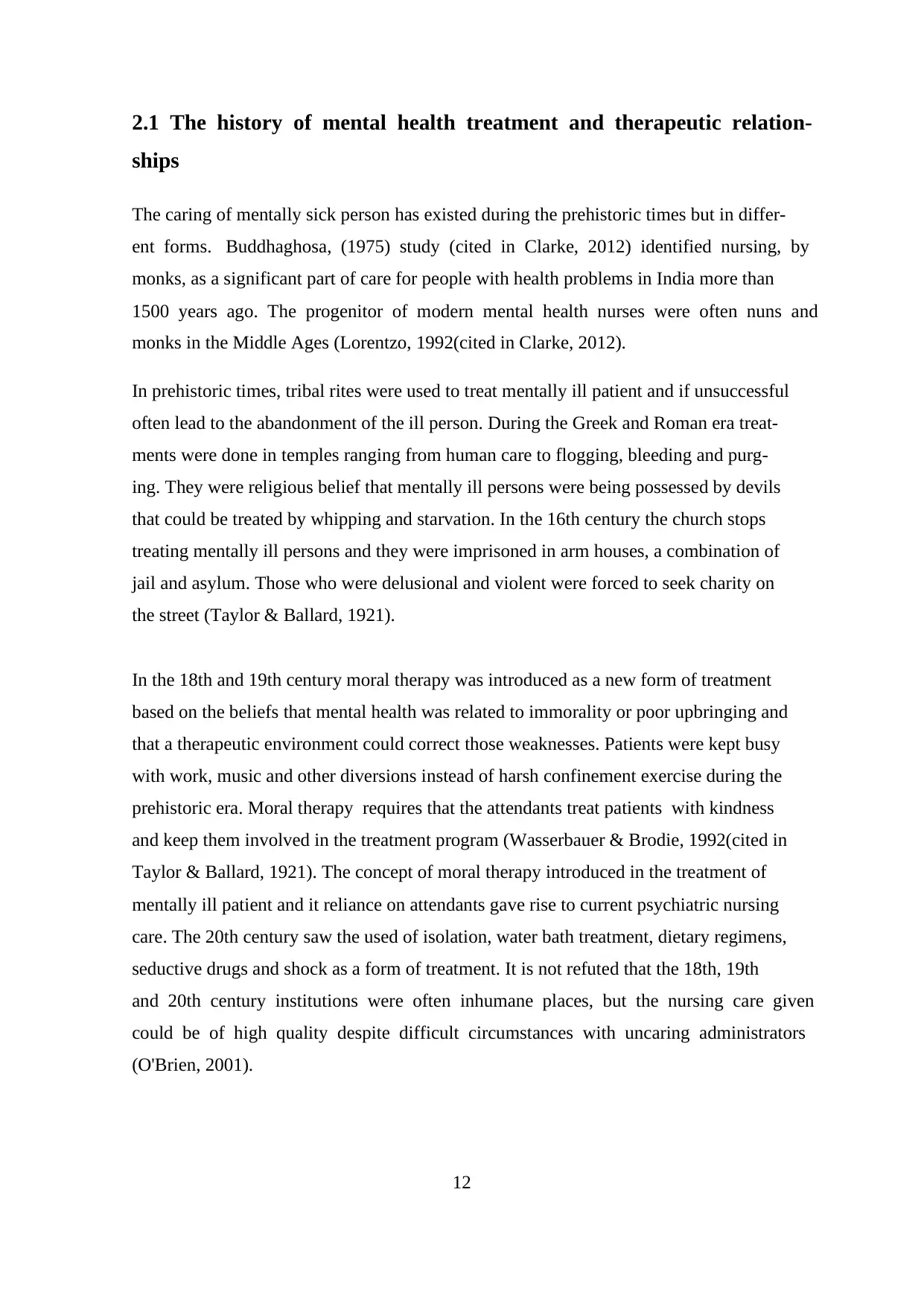
12
2.1 The history of mental health treatment and therapeutic relation-
ships
The caring of mentally sick person has existed during the prehistoric times but in differ-
ent forms. Buddhaghosa, (1975) study (cited in Clarke, 2012) identified nursing, by
monks, as a significant part of care for people with health problems in India more than
1500 years ago. The progenitor of modern mental health nurses were often nuns and
monks in the Middle Ages (Lorentzo, 1992(cited in Clarke, 2012).
In prehistoric times, tribal rites were used to treat mentally ill patient and if unsuccessful
often lead to the abandonment of the ill person. During the Greek and Roman era treat-
ments were done in temples ranging from human care to flogging, bleeding and purg-
ing. They were religious belief that mentally ill persons were being possessed by devils
that could be treated by whipping and starvation. In the 16th century the church stops
treating mentally ill persons and they were imprisoned in arm houses, a combination of
jail and asylum. Those who were delusional and violent were forced to seek charity on
the street (Taylor & Ballard, 1921).
In the 18th and 19th century moral therapy was introduced as a new form of treatment
based on the beliefs that mental health was related to immorality or poor upbringing and
that a therapeutic environment could correct those weaknesses. Patients were kept busy
with work, music and other diversions instead of harsh confinement exercise during the
prehistoric era. Moral therapy requires that the attendants treat patients with kindness
and keep them involved in the treatment program (Wasserbauer & Brodie, 1992(cited in
Taylor & Ballard, 1921). The concept of moral therapy introduced in the treatment of
mentally ill patient and it reliance on attendants gave rise to current psychiatric nursing
care. The 20th century saw the used of isolation, water bath treatment, dietary regimens,
seductive drugs and shock as a form of treatment. It is not refuted that the 18th, 19th
and 20th century institutions were often inhumane places, but the nursing care given
could be of high quality despite difficult circumstances with uncaring administrators
(O'Brien, 2001).
2.1 The history of mental health treatment and therapeutic relation-
ships
The caring of mentally sick person has existed during the prehistoric times but in differ-
ent forms. Buddhaghosa, (1975) study (cited in Clarke, 2012) identified nursing, by
monks, as a significant part of care for people with health problems in India more than
1500 years ago. The progenitor of modern mental health nurses were often nuns and
monks in the Middle Ages (Lorentzo, 1992(cited in Clarke, 2012).
In prehistoric times, tribal rites were used to treat mentally ill patient and if unsuccessful
often lead to the abandonment of the ill person. During the Greek and Roman era treat-
ments were done in temples ranging from human care to flogging, bleeding and purg-
ing. They were religious belief that mentally ill persons were being possessed by devils
that could be treated by whipping and starvation. In the 16th century the church stops
treating mentally ill persons and they were imprisoned in arm houses, a combination of
jail and asylum. Those who were delusional and violent were forced to seek charity on
the street (Taylor & Ballard, 1921).
In the 18th and 19th century moral therapy was introduced as a new form of treatment
based on the beliefs that mental health was related to immorality or poor upbringing and
that a therapeutic environment could correct those weaknesses. Patients were kept busy
with work, music and other diversions instead of harsh confinement exercise during the
prehistoric era. Moral therapy requires that the attendants treat patients with kindness
and keep them involved in the treatment program (Wasserbauer & Brodie, 1992(cited in
Taylor & Ballard, 1921). The concept of moral therapy introduced in the treatment of
mentally ill patient and it reliance on attendants gave rise to current psychiatric nursing
care. The 20th century saw the used of isolation, water bath treatment, dietary regimens,
seductive drugs and shock as a form of treatment. It is not refuted that the 18th, 19th
and 20th century institutions were often inhumane places, but the nursing care given
could be of high quality despite difficult circumstances with uncaring administrators
(O'Brien, 2001).
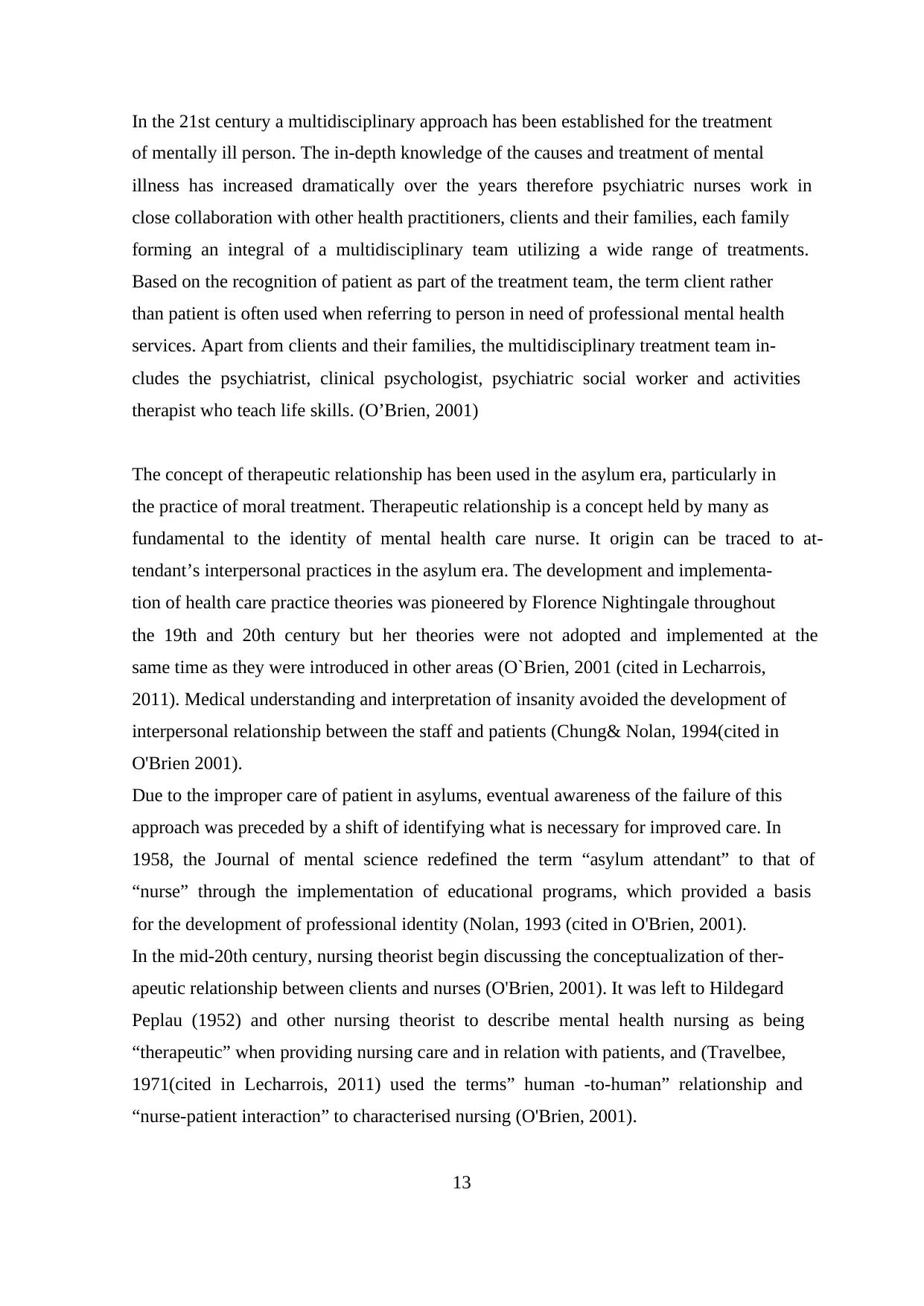
13
In the 21st century a multidisciplinary approach has been established for the treatment
of mentally ill person. The in-depth knowledge of the causes and treatment of mental
illness has increased dramatically over the years therefore psychiatric nurses work in
close collaboration with other health practitioners, clients and their families, each family
forming an integral of a multidisciplinary team utilizing a wide range of treatments.
Based on the recognition of patient as part of the treatment team, the term client rather
than patient is often used when referring to person in need of professional mental health
services. Apart from clients and their families, the multidisciplinary treatment team in-
cludes the psychiatrist, clinical psychologist, psychiatric social worker and activities
therapist who teach life skills. (O’Brien, 2001)
The concept of therapeutic relationship has been used in the asylum era, particularly in
the practice of moral treatment. Therapeutic relationship is a concept held by many as
fundamental to the identity of mental health care nurse. It origin can be traced to at-
tendant’s interpersonal practices in the asylum era. The development and implementa-
tion of health care practice theories was pioneered by Florence Nightingale throughout
the 19th and 20th century but her theories were not adopted and implemented at the
same time as they were introduced in other areas (O`Brien, 2001 (cited in Lecharrois,
2011). Medical understanding and interpretation of insanity avoided the development of
interpersonal relationship between the staff and patients (Chung& Nolan, 1994(cited in
O'Brien 2001).
Due to the improper care of patient in asylums, eventual awareness of the failure of this
approach was preceded by a shift of identifying what is necessary for improved care. In
1958, the Journal of mental science redefined the term “asylum attendant” to that of
“nurse” through the implementation of educational programs, which provided a basis
for the development of professional identity (Nolan, 1993 (cited in O'Brien, 2001).
In the mid-20th century, nursing theorist begin discussing the conceptualization of ther-
apeutic relationship between clients and nurses (O'Brien, 2001). It was left to Hildegard
Peplau (1952) and other nursing theorist to describe mental health nursing as being
“therapeutic” when providing nursing care and in relation with patients, and (Travelbee,
1971(cited in Lecharrois, 2011) used the terms” human -to-human” relationship and
“nurse-patient interaction” to characterised nursing (O'Brien, 2001).
In the 21st century a multidisciplinary approach has been established for the treatment
of mentally ill person. The in-depth knowledge of the causes and treatment of mental
illness has increased dramatically over the years therefore psychiatric nurses work in
close collaboration with other health practitioners, clients and their families, each family
forming an integral of a multidisciplinary team utilizing a wide range of treatments.
Based on the recognition of patient as part of the treatment team, the term client rather
than patient is often used when referring to person in need of professional mental health
services. Apart from clients and their families, the multidisciplinary treatment team in-
cludes the psychiatrist, clinical psychologist, psychiatric social worker and activities
therapist who teach life skills. (O’Brien, 2001)
The concept of therapeutic relationship has been used in the asylum era, particularly in
the practice of moral treatment. Therapeutic relationship is a concept held by many as
fundamental to the identity of mental health care nurse. It origin can be traced to at-
tendant’s interpersonal practices in the asylum era. The development and implementa-
tion of health care practice theories was pioneered by Florence Nightingale throughout
the 19th and 20th century but her theories were not adopted and implemented at the
same time as they were introduced in other areas (O`Brien, 2001 (cited in Lecharrois,
2011). Medical understanding and interpretation of insanity avoided the development of
interpersonal relationship between the staff and patients (Chung& Nolan, 1994(cited in
O'Brien 2001).
Due to the improper care of patient in asylums, eventual awareness of the failure of this
approach was preceded by a shift of identifying what is necessary for improved care. In
1958, the Journal of mental science redefined the term “asylum attendant” to that of
“nurse” through the implementation of educational programs, which provided a basis
for the development of professional identity (Nolan, 1993 (cited in O'Brien, 2001).
In the mid-20th century, nursing theorist begin discussing the conceptualization of ther-
apeutic relationship between clients and nurses (O'Brien, 2001). It was left to Hildegard
Peplau (1952) and other nursing theorist to describe mental health nursing as being
“therapeutic” when providing nursing care and in relation with patients, and (Travelbee,
1971(cited in Lecharrois, 2011) used the terms” human -to-human” relationship and
“nurse-patient interaction” to characterised nursing (O'Brien, 2001).
⊘ This is a preview!⊘
Do you want full access?
Subscribe today to unlock all pages.

Trusted by 1+ million students worldwide
1 out of 50
Related Documents
Your All-in-One AI-Powered Toolkit for Academic Success.
+13062052269
info@desklib.com
Available 24*7 on WhatsApp / Email
![[object Object]](/_next/static/media/star-bottom.7253800d.svg)
Unlock your academic potential
Copyright © 2020–2025 A2Z Services. All Rights Reserved. Developed and managed by ZUCOL.




